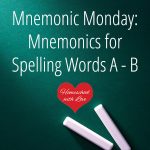
No two children learn alike. They all have unique learning experiences and styles. Some tend to be more right-brain dominant, others are left-brain dominant, and a few are blessed to be middle brain because they use both hemispheres fairly equally.
Children who are analytical are left-brain dominant and learn best by seeing the parts of a whole. Children who think more holistically are right-brain dominant and learn best by seeing the whole first. One of the benefits of homeschooling is that you can make accommodations for the way your child learns while at the same time improving areas that he is needy in. Here are some ways to identify your child’s learning preference.
*This post contains paid links. I earn a small commission from the sale of products purchased via these links. Please see my disclosure for details.
How Your Child Learns
Parts-to-Whole Learners
How do you know if your child is a parts-to-whole learner? Ask yourself these questions about him:
- Does your child prefer to learn things step-by-step?
- Does he like to start with the facts and move on toward the big picture?
- Does he like to analyze things?
- Does he like to break things down into smaller parts?
- Does he like to put things in a logical order?
- Is he more cautious?
- Does he like to be precise?
If you answered “yes” to all or most of these questions, then your child probably learns best with a parts to whole approach. A good deal of traditional textbooks and workbooks are set up this way. That certainly makes it easier for you. Here are some things to consider when teaching individual subjects.
When learning to read, this type of child learns best with phonics by seeing and hearing how each letter makes the whole word. This type of learner can sound out words better than a holistic learner.
In spelling, it is helpful for this child to see how the parts of the word make the whole. A long word like “indispensable” could be broken up into parts to look like this “in-dis-pens-able” to help facilitate learning. Sounding out also helps this learner.
With grammar, learning the structure of the language is beneficial. Teach the parts of speech and how they work together. Show the rules of our language to help a parts-to-whole learner.
Math tends to be a little easier for this type of learner since he is analytical. Help him to learn the steps and rules for solving math problems.
In history, this child likes to learn about individual events and how they lead up to major events. Most history books are already set up in way that works for this type of learner.
For science, it is good for this type of child to follow the steps of an experiment. When learning about ecosystems or systems like digestion, show him how the parts like the mouth, esophagus, stomach, etc. work together.
Whole-to-Parts Learners
How can you tell if your child is a whole-to-parts learner? Ask yourself these questions about her:
- Does your child prefer to look at the big, overall picture?
- Does she like to see relationships among things?
- Is she good at recognizing patterns?
- Does she prefer pictures over words and numbers?
- Does she act on emotion more than logic?
- Is she a risk taker?
- Is she very imaginative?
If most or all of these describe your child, then your child learns best by seeing the whole first. If you have a curriculum that is parts to whole, all is not lost. There are modifications that can be made. Here are some tips on what you can do to help a whole-to-parts learner.
It’s a good idea for children like this to skim through a chapter before reading it. This gives them the big picture first. It is also helpful for the child to pay special attention to the images in a textbook since holistic learners prefer pictures. When taking notes, this child can draw pictures and use colors to aid in comprehension. Humor helps this sort of child since emotion helps them learn.
When teaching reading, point out the whole word first before breaking it up into its phonetic parts. Use colors to distinguish things like silent e’s or new sounds or rules.
In spelling, it is a good idea to use colors to make certain parts of a word stand out, especially parts the child struggles to remember. Colors can be used to point out rules and patterns too. I demonstrated some ways to use color with spelling in the article Making Spelling More Fun.
Math can sometimes be more challenging for whole-to-parts learners. Show examples of problems worked out from start to finish so that they can see the whole picture. A math series like Life of Fred could help because it uses a funny story to teach math.
When teaching history, timelines with pictures are beneficial. This lets the child see the whole picture of events in an era. I wrote an article on using timelines to teach history that you might want to check out.
In science, images and diagrams can help this type of learner. Show your child a picture of the whole digestive system before looking at the individual parts.
Middle Brain
There are some people who use both hemispheres to the same degree. This is wonderful! With this type of child, you might find that just about any approach to learning works. Experiment and you’ll find the best approach.
Reap the Benefits of Both
Each side of the brain has its own unique gifts. Everyone can benefit from both. Keep that in mind as you homeschool your child. While it is helpful to teach to the dominant side of the brain, it is wise to also include activities occasionally that use the other side. This will enable both you and your child to grow.
I’ve experienced this growth first had with my own dear children. I am a left-brain, parts-to-whole learner. I was blessed with one child who is right-brain and one that is middle brain. This has forced me to improve my teaching and use both parts-to-whole and whole-to-parts methods.
So what kind of learners were you blessed with? What homeschool methods have worked well for them? I would love to hear your input.







